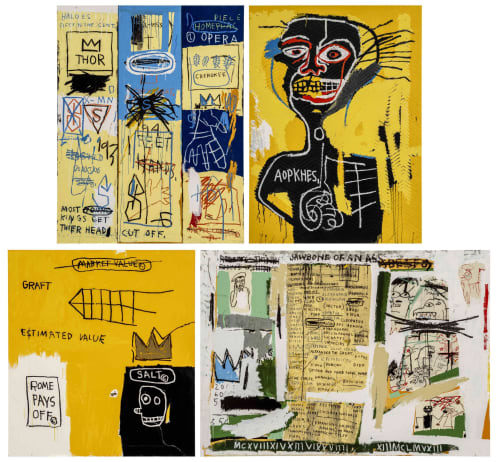Jean-Michel Basquiat’s Portfolio II, a compelling collection of four screenprints, presents a multifaceted exploration of cultural identity, history, and personal mythology. Each piece, imbued with Basquiat’s characteristic blend of raw energy and intense symbolism, invites viewers into a dialogue about social constructs, power structures, and self-perception.
Charles the First pays homage to jazz legend Charlie Parker, a figure Basquiat revered for his groundbreaking contributions to American music and culture. In this work, Basquiat merges the crown motif—a symbol he frequently used to highlight cultural royalty and individual greatness—with references to Parker’s struggles and triumphs. The phrase “most young kings get their head cut off” appears in the piece, evoking both the fleeting nature of fame and the pressures faced by those who challenge conventions. Through this symbolic language, Basquiat addresses the vulnerability of cultural icons, a reminder of how society simultaneously elevates and devours its heroes.
Cabeza (Spanish for “head”) is a profound examination of identity and memory, centered around a hauntingly expressive skull. This work reflects Basquiat’s preoccupation with anatomical imagery and his ongoing exploration of how society remembers historical and contemporary figures. By combining skull imagery with raw brushwork and text, Basquiat critiques how societies construct narratives around individuals, often reducing complex identities to simple icons or symbols. In Cabeza, the skull embodies the fragility of identity, revealing how individuals are remembered—or erased—through history’s lens.
Rome Pays Off features chaotic scrawls and graffiti-like text, weaving together the themes of capitalism and conquest. This piece reflects Basquiat’s view of contemporary society as a constant struggle for dominance, wealth, and legacy, echoing the historical impact of the Roman Empire. Basquiat uses phrases like “man-made” and “worthless,” suggesting a critique of materialism and the artificial constructs of value imposed by society. Here, he underscores a disconnect between material wealth and true worth, highlighting how cultures reward conquest but often overlook the deeper costs of ambition and power.
Jawbone of an Ass draws from the biblical story of Samson, who used a jawbone to defeat his enemies. This narrative, which emphasizes strength and resilience, resonates with Basquiat’s own experiences as a Black artist navigating a predominantly white art world. Through his layered symbolism, Basquiat elevates the jawbone to represent the power of speech and the resilience required to challenge social injustice. In this piece, he uses expressive strokes and a fractured style to evoke the raw, combative energy of both physical and intellectual battles, pointing to art’s capacity to question authority and spark change.
Portfolio II serves as a cultural critique, tackling issues of fame, identity, power, and resilience. Basquiat’s use of fragmented text and symbolic imagery in each piece invites viewers to contemplate the legacies we create and the systems that shape them. As a collection, Portfolio II exemplifies Basquiat’s role as a provocateur and storyteller, positioning art as both a reflection of cultural struggles and a platform for reshaping them.
Discover our selection of Jean Michel Basquiat signed prints for sale and contact info@guyhepner.com. Looking to sell? We can help you. Read about how to sell your Basquiat prints at Guy Hepner.

